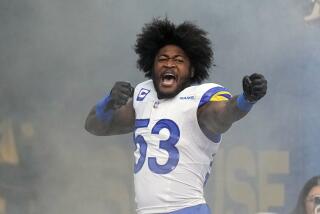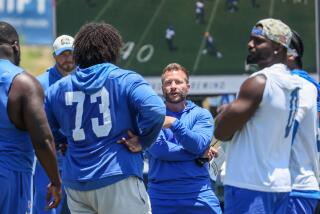RAMS : As Free Agency Looms, Plan B Loses Some of Its Luster
Any notion of a Plan B panacea is dead and buried. What killed it is what lurks in the near future, the one seismic issue that keeps owners awake at night: Real, honest, wallet-crunching free agency.
And, believe it, the Rams, even more keenly than most, are watching what develops.
Plan B, in past years, was used by several teams to add depth to rosters and load up on other team’s rejects to challenge their own retreads. These clubs handed out six-figure signing bonuses to players who never had a chance of making an impact.
When Green Bay almost made the playoffs after signing 17 Plan B players, the Packers were lauded for their foresight and many in the league began to think of Plan B as a quick-fix mini-draft.
Some teams used it wisely--the Washington Redskins spent big bucks on a few players who were key in their Super Bowl drive last season. Some teams didn’t--Green Bay has dropped millions into the Plan B bucket and is still, after the one decent season, stuck in mediocrity.
The Rams have tread the middle ground. They have picked up players here and there--they have signed three this year after the acquisition of former Seattle running back Derek Loville Wednesday. And they have lost players here and there, realizing that if and when true free agency arrives, it would make Plan B seem like shopping at K mart.
Why bid hundreds of thousands of dollars for the Phoenix Cardinals’ 38th-best player now, when maybe next year, you’ll be racing everybody else to call Reggie White’s agent with another zero to add to your latest proposal?
If there’s a frenzy for a guy named John Bruhin (a guard who left Tampa for a six-figure bonus from Philadelphia this spring), what’s it going to be for Jim Lachey? Who can afford Plan B when they have to Plan Ahead for free agency?
This year, with the long-awaited (Freeman) McNeil vs. the NFL court case set to start in June and with even league hardliners admitting the league could get free agency forced upon them because of the court case, the Plan B floodgates are closing.
In each of the first three years of Plan B, which was designed to thwart challenges to the free-agency system by the NFL Players Assn., an average of 184 players changed teams.
Unless there’s an overwhelming change before the 2 p.m. April 1 deadline, this year’s Plan B tally might not hit three digits. That June court date is a bigger, more imposing deadline, blotting out everything else.
Once real free agency happens, whether through a jury decision or, more likely, by a labor settlement, everything changes.
The Rams, positioned at the bottom of the talent rung but with long-range possibilities and can’t-miss location, could be the first and quite possibly the foremost to recognize the new era.
Without free agency, the Rams have been tight-fisted, but it didn’t kill them. They could afford to be thoroughly bottom-line conscious because as long as a team drafted well, it would always have the players to compete.
Once you drafted them, they were yours forever, and whatever salary haggling that occurred during their careers could be solved because what other choices did they have? Zero.
The Rams didn’t flop the past two seasons because they wouldn’t spend like the 49ers or Redskins, they flopped because they couldn’t get the first part right: They drafted blindly, blandly and with a lack of the basic instinct it takes to create success.
But with true free agency, that’s totally different. If, say, after four seasons any unsigned veteran player can bolt to another club without restrictions, the hardline is out the window.
With free agency, there’s no way the Rams could have traded a disgruntled (and underpaid) Eric Dickerson for the bounty of choices they later wasted. He would’ve been gone with little compensation, a Bobby Bonilla in shoulder pads.
With true free agency, the Rams’ front office knows free agency brings a different sort of player-team relationship. You have to court players, keep them happy and create an atmosphere that front-line players from other teams want to join. Otherwise, you’re the Cleveland Indians.
Are the Rams blind to this? John Shaw didn’t get to be one of the league’s most feared negotiators by being deaf, dumb or blind.
And with a roster that isn’t exactly sizzling with hot, potential 1993 free agents, don’t be shocked to see the penny-pinching, bottom-dollar Rams wade into the new era with the vault door cracked open.
The Rams agreed to a two-year, $700,000 contract with Loville. The other two Plan B acquisitions are center Blair Bush and receiver Jeff Chadwick; all three used to play in Seattle under Ram Coach Chuck Knox.
Loville, a 5-foot-9 running back going into his third season, ran 22 times for 69 yards last year and returned 18 kickoffs for a 22.9-yard average. The Rams apparently plan to use Loville as a third-down back and on special teams.
Here’s another big reason Plan B is a relic of the past: Teams have figured out how to bend the rules. So many unprotected players have cut under-the-table deals with their teams that the layer of attractive players is stretched horribly thin.
What you get, then, is tremendous bidding for the top 20 or 30 players (including guard Bruce Reimers, tailback James Brooks and linebacker Carl Zander, all of whom left Cincinnati--Do you get the feeling the Bengals haven’t quite mastered this yet?), and a thick, dull bunch of players after that.
“Plan B, when it first came in, was going to be great, going to be a great thing,” says Rams’ pro personnel director Jack Faulkner. “Because it gave some sort of free agency for the players.
“But this thing has changed around. This year, everybody’s been through a couple of it, and it’s like anything you’ve been through a couple times, everybody’s finding loopholes, especially in this business, a way to get around something.”
The new way to cheat the rules is to offer new, lucrative contracts to the unprotected players you want to keep, but make the terms official only if the players are still with the team after April 1. The players can take the money now or test the market for the money in the bush, and almost all of them aren’t dummies.
The Rams, for instance, brought in Buffalo tackle Joe Staysniak, started talking money with him, then were surprised when he told them he wasn’t going to leave Buffalo, after all. He had a deal.
The Rams, for instance, have a tentative agreement with defensive tackle Mike Piel that will almost certainly keep him with the team despite being left off the protected list. But the Rams last year also thought they had an agreement with tight end Pete Holohan before he bolted to Kansas City. Tuesday, he left the Chiefs for the Cleveland Browns.
Ram Notes
Last year, the Rams signed seven players, and all seven made their regular-season roster, with Tony Zendejas being the star of the class and cornerback Rodney Thomas (released during the season) at the low end. So far, the Rams have signed Bush, Chadwick and Loville, and may end up with five, six at the most, with most of their attention focusing on Phoenix nose tackle Chris Williams and Kansas City tackle Tom Dohring. . . . The Rams have lost long-snapper Mike McDonald and guard Duval Love, and other teams are interested in linebackers Paul Butcher and Brett Faryniarz. . . . As the deadline to make a decision comes nearer, it appears the Rams, after exploring several other options, will return to UC Irvine for this year’s training camp.


